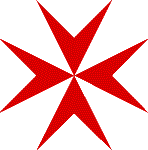| Revision as of 12:03, 22 April 2006 view source86.128.210.188 (talk)No edit summary← Previous edit | Revision as of 12:04, 22 April 2006 view source 86.128.210.188 (talk)No edit summaryNext edit → | ||
| Line 1: | Line 1: | ||
| ] | ] | ||
| There are myths legends and anecdotes for the existence of Knights Templar in Scotland going back to the Battle of Bannockburn, with suggestions that Templars fleeing the suppression in France in 1312 found refuge in Scotland, whose King, Robert the Bruce, had been excommunicated by the Pope. While Knights Templar Internationally use the Croix Pattee, the Scottish Knights Templar use the Eight Pointed Cross more commonly associated with Malta, and the Knights Hospitaller or Order of St John, the white changed to the blood red of The Order. This, it is said, is because they were given refuge by the Order of St John. | There are myths legends and anecdotes for the existence of Knights Templar in Scotland going back to the Battle of Bannockburn, with suggestions that Templars fleeing the suppression in France in 1312 found refuge in Scotland, whose King, Robert the Bruce, had been excommunicated by the Pope. While Knights Templar Internationally use the Croix Pattee, the Scottish Knights Templar use the Eight Pointed Cross more commonly associated with Malta, and the Knights Hospitaller or Order of St John, the white changed to the blood red of The Order. This, it is said, is because they were given refuge by the Order of St John. | ||
| It is said that Bonnie Dundee, James Graham of Claverhouse, was found to be wearing the Grand Cross of the Order when he was killed at the Battle of Killiecrankie in 1689. Prince Charles Edward Stewart gave a soiree for the Chivalry of the Order in Edinburgh in 1745 during the Jacobite Rising. The Modern Order began in 1810 when Alexander Deuchar became the Master, a title he held for 25 years. Today The Order is Christian, Ecumenical and open to both Women and Men, and seeks to promote Christian chivalric ideals and advances the knowledge of Scottish History and Culture both at home and in the world. | It is said that Bonnie Dundee, James Graham of Claverhouse, was found to be wearing the Grand Cross of the Order when he was killed at the Battle of Killiecrankie in 1689. Prince Charles Edward Stewart gave a soiree for the Chivalry of the Order in Edinburgh in 1745 during the Jacobite Rising. The Modern Order began in 1810 when Alexander Deuchar became the Master, a title he held for 25 years. Today The Order is Christian, Ecumenical and open to both Women and Men, and seeks to promote Christian chivalric ideals and advances the knowledge of Scottish History and Culture both at home and in the world. | ||
| == External Links == | |||
| * Website for the Modern Order of Knights Templar in Scotland | * Website for the Modern Order of Knights Templar in Scotland | ||
Revision as of 12:04, 22 April 2006
There are myths legends and anecdotes for the existence of Knights Templar in Scotland going back to the Battle of Bannockburn, with suggestions that Templars fleeing the suppression in France in 1312 found refuge in Scotland, whose King, Robert the Bruce, had been excommunicated by the Pope. While Knights Templar Internationally use the Croix Pattee, the Scottish Knights Templar use the Eight Pointed Cross more commonly associated with Malta, and the Knights Hospitaller or Order of St John, the white changed to the blood red of The Order. This, it is said, is because they were given refuge by the Order of St John. It is said that Bonnie Dundee, James Graham of Claverhouse, was found to be wearing the Grand Cross of the Order when he was killed at the Battle of Killiecrankie in 1689. Prince Charles Edward Stewart gave a soiree for the Chivalry of the Order in Edinburgh in 1745 during the Jacobite Rising. The Modern Order began in 1810 when Alexander Deuchar became the Master, a title he held for 25 years. Today The Order is Christian, Ecumenical and open to both Women and Men, and seeks to promote Christian chivalric ideals and advances the knowledge of Scottish History and Culture both at home and in the world.
External Links
- Scottish Knights Templar Website for the Modern Order of Knights Templar in Scotland
